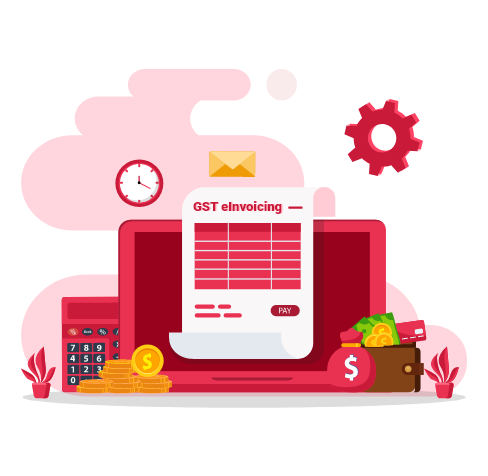

Where to get your GST eInvoicing from? We are here for you at Business Buddy Solutions.

GST eInvoice has been introduced in India to usher in the digital era from conventional paper-based systems. eInvoicing can help businesses achieve tremendous cost savings and efficiency and speed up business operations. eInvoicing will help reduce the compliance burden for most businesses by eliminating the requirement for duplication or transfer of the same information from one system to another. With eInvoicing, the invoice information provided to GSTN for generating Invoice Reference Numbers (IRN) would auto-populate various other systems’ GST returns, input tax credit reconciliation, eWay bill, and GST refunds. Hence, GST eInvoicing will significantly improve the ease of business and reduce the compliance burden.
The process of generation of a GST eInvoice can be divided into four phases:
In the first phase, the seller generates an invoice in their accounting, billing, or ERP system. The invoice created must take into consideration the eInvoice standards that have been published by the GSTN and should contain specific mandatory parameters. The invoice prepared on the software should then be transmitted to the Invoice Registration Portal in JSON format.
The seller accounting software, through APIs or GSP/ASP or offline tools, will be required to transmit the invoice in JSON format to the Invoice Registration Portal. The JSON can be uploaded directly from accounting software through APIs.
The IRP will check the JSON invoice received for the correctness and ensure that the same invoice from the supplier is not duplicated. On validation of the JSON invoice, the IRP will add its digital signature and assign an IRN (Invoice Reference Number) and a QR code to the JSON file. This digitally signed JSON with IRN is sent back to the seller and will become a valid GST eInvoice for the seller and buyer.
IRPs will also share the signed eInvoice data with the GSTN system and the eWay Bill portal to reduce the compliance burden for the taxpayers.
Advantages of GST eInvoice
GST eInvoicing will completely transform the business process, as there are currently no standards defined for invoices. With the implementation of eInvoicing, invoicing would be standardized across the entire GST eco-system. So an eInvoice generated by one software can be read by another, eliminating the need for data transfer or re-entry. Finally, eInvoicing will eliminate the process of compilation of invoices at the end of the month and make input tax credit flow seamless.
Key Concepts of eInvoicing
The following are some of the key concepts concerning GST eInvoicing:
GST eInvoice is not an invoice generated on the Government Portal; such a portal can become a choke point in trade. GST eInvoicing is a process by which the taxpayer will generate a unique Invoice Reference Number (IRN) for each invoice and mention the same on the invoice issued.
The Invoice Reference Number is a unique number for each invoice provided by the GST Invoice Registration Portal on successfully uploading an eInvoice. The supplier must mention the Invoice Reference Number to comply with eInvoicing regulations.
There is no specific format for eInvoice that the GSTN has provided. The invoice that is prepared and printed today will remain the same. Under eInvoicing, specific data in the GST invoice will be transmitted to the GSTN Invoice Registration Portal (IRP) electronically. An Invoice Reference Number will be generated along with a QR code. The QR code needs to be printed on the invoice generated by the supplier. Hence, suppliers can continue to generate invoices from their billing softwares with a look and feel that suits their requirements and is compliant with the GST invoicing rules. The only change will be the generation of the Invoice Reference Number from the GST Invoice Registration Portal and the printing the eInvoice QR code on the invoice.
Invoice Registration Portal (IRP)
The invoice Registration Portal (IRP) or eInvoice Registrar is the platform issuing the Invoice Reference Number. NIC has been proposed as the first IRP. As the number of taxpayers under eInvoicing increases, more IRPs will be added to increase availability and speed and create a distributed architecture.
Invoice Reference Number (IRN)
Each invoice uploaded by a seller to the Invoice Registration Portal and validated will receive an Invoice Reference Number (IRN). IRN is a 64 characters long, unique number in the GST system – irrespective of the taxpayer, financial year, and document type. The Invoice Registration Portal will issue IRN on uploading the JSON invoice file. IRN will be generated based on the supplier GSTIN, document type, document number, and year of invoice. Document types are INV for the invoice, CRN for the credit note, and DBN for the debit note.
eInvoice QR Code
The IRP will digitally sign a JSON invoice submitted by the seller and generate a QR code containing the unique IRN along with other invoice data so that it can be readily verified online. This QR code can be scanned by the buyer or any tax offer using an app to check the invoice’s validity. The eInvoice QR code will contain the following information:
The GST eInvoice will be similar to the existing GST invoice format. The GSTN has clarified that the seller does not require writing IRN (64 characters). However, the IRN will be included in the QR code provided by the Invoice Registration Portal. The QR code will contain details of the invoice and the IRN. Thus, it is better to make a digitally signed QR code as a response which will be proof of invoice registration and print on invoices issued by a business.
Why Choose Business Buddy Solutions?
Copyright © 2020 Businessbuddysolutions.com All Rights Reserved